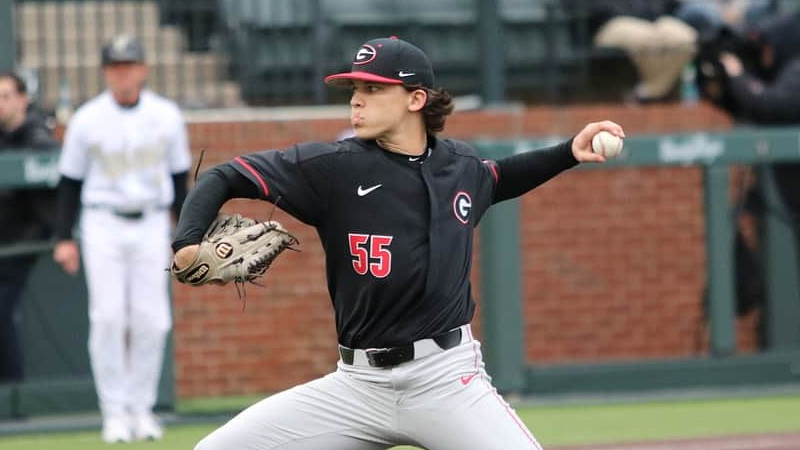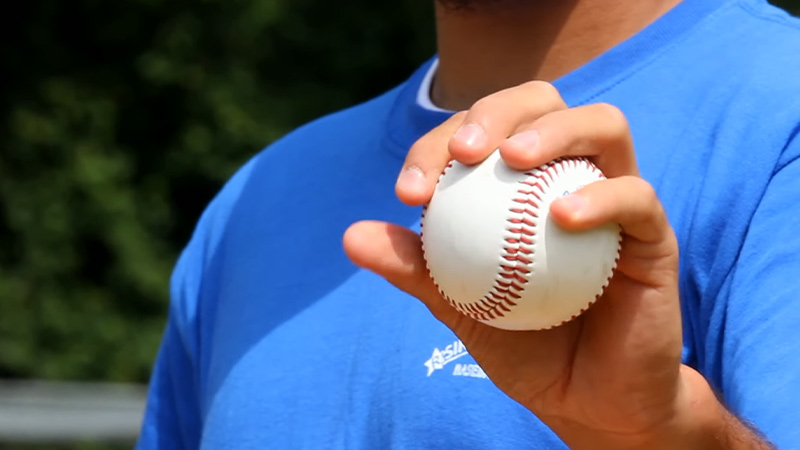Baseball is a sport that embraces a wide array of pitching techniques, each designed to deceive and outsmart the batter. One such pitch that has gained popularity among pitchers is the palmball pitch. The palmball is an off-speed pitch that relies on grip and finesse rather than sheer velocity.
But how to throw a palmball pitch? In this article, we will delve into the mechanics and techniques required to master the art of throwing a palmball pitch.
What Is a Palmball Pitch?
The palmball pitch is a type of pitch used in baseball. It is considered a changeup, designed to deceive the batter by disrupting the timing and velocity of the pitch. The palmball pitch is typically thrown with a grip where the ball rests in the palm of the hand, hence its name.
When throwing a palmball pitch, the pitcher grips the ball deep in the palm, usually with the fingers spread wide apart and the thumb resting on the side. The ball is held loosely, allowing for minimal contact with the fingertips.
This grip creates a larger surface area of contact with the palm, which generates additional friction and slows down the pitch. As the pitcher throws the palmball, they typically use the same arm motion and delivery as their fastball.
However, due to the loose grip and reduced arm speed, the pitch comes out of the hand at a slower speed, creating the changeup effect. The goal is to make the batter anticipate a fastball, only to be caught off guard by the slower pitch.
It’s worth noting that the palmball pitch is not as commonly used as other pitches like fastballs, curveballs, or sliders. Pitchers with exceptional control and a good feel for the pitch may choose to incorporate it into their repertoire to keep hitters off balance.
When to Throw A Palmball Pitch?
The palmball pitch can be used in various situations during a baseball game. Here are some common scenarios where a pitcher might choose to throw a palmball pitch:
Change of Speed
The palmball is primarily a changeup pitch designed to disrupt the batter’s timing by offering a slower speed compared to the pitcher’s fastball. It can be effective when the pitcher wants to keep the batter off balance and prevent them from timing their swing correctly.
Two-Strike Count
When the pitcher has two strikes on the batter, they might opt to throw a palmball pitch as a strikeout pitch. The change of speed can fool the batter, causing them to swing early or generate weak contact.
Off-Speed Pitch
The palmball can be used as an off-speed pitch alongside other breaking balls, such as curveballs or sliders. By mixing up the speeds and movement of pitches, the pitcher can keep the batter guessing and prevent them from sitting on a particular pitch.
Against Aggressive Hitters
If the pitcher is facing a hitter known for aggressive swinging or frequently chasing pitches out of the strike zone, a palmball can be effective in tempting them to swing early or commit to a pitch they cannot make solid contact with.
Variability
Incorporating a palmball into a pitcher’s repertoire provides additional variability and unpredictability. By having a different speed option, the pitcher can keep the opposing hitters from getting comfortable and easily adjusting to their pitches.
How to Throw A Palmball Pitch?
To throw a palmball pitch, follow these steps:
Grip the Ball
Hold the baseball deep in the palm of your hand. Place your fingers widely spread apart, with your thumb resting on the side of the ball. The ball should rest against the base of your fingers, with minimal contact with the fingertips. This loose grip will allow for reduced ball rotation and generate additional friction when released.

Source: baseballbible.net
Adjust Hand Position
Position your hand in a way that feels comfortable and secure for you. Some pitchers prefer to tuck their ring and pinky fingers slightly against the side of the ball, while others keep all fingers spread wide apart.
Arm Motion
Maintain the same arm motion and delivery as you would for a fastball. It’s important to use a consistent throwing motion to maintain deception and not tip off the batter about the upcoming pitch type.
Focus on Speed Reduction
The key to the palmball pitch is reducing the speed of the pitch compared to your fastball. To achieve this, loosen your grip and allow the ball to roll out of your hand with less force. This will result in a slower release and reduced velocity.
Practice and Adjust
It’s crucial to practice throwing the palmball pitch to develop the right feel and control. Experiment with the grip and hand positioning to find what works best for you. Pay attention to the speed and movement of the pitch and make adjustments as needed to achieve the desired effect.
Remember, the palmball pitch is primarily a changeup, so it should be used sparingly to keep the batter off balance. Developing good command and control of the pitch will allow you to effectively mix it with your other pitches and enhance your overall pitching repertoire.
Why Don’t More Pitchers Throw A Palmball Pitch?
The palmball pitch is not as commonly used as other pitches in baseball for a few reasons:
Difficulty and Control
The palmball pitch requires a delicate balance of grip and release to achieve the desired effect. It can be challenging to consistently throw the pitch with accuracy and control, especially at higher levels of the game. Pitchers need to invest significant time and practice to develop the necessary feel and command for the pitch.
Lack of Movement
Compared to other off-speed pitches like curveballs or changeups with pronounced movement, the palmball typically has less break or deception. While it can disrupt a batter’s timing due to the change in speed, the lack of significant movement may make it less appealing to some pitchers.
Repertoire Preference
Pitchers often develop their repertoire based on their personal strengths, comfort, and success with certain pitches. Many pitchers prefer to focus on their fastball, breaking balls (like sliders or curveballs), or traditional changeups, which they may find more effective and reliable for their particular style and skill set.
Risk of Injury
The palmball pitch, like other changeup pitches, relies on reducing arm speed and manipulating the grip. While it can be effective, pitchers need to be cautious about altering their mechanics too drastically, as it can potentially increase stress on the arm and lead to injury.
Some pitchers and coaches may opt for other off-speed pitches that don’t require as much adjustment in mechanics.
Scouting and Hitting Adjustments
With the advancements in scouting and technology, hitters have become more adept at identifying pitch types and making adjustments.
The palmball, being a less common pitch, may not be as effective against well-prepared and disciplined hitters who can quickly recognize the change in speed and adjust their swing accordingly.
While the palmball pitch has its merits and can be an effective tool in the right hands, these factors contribute to its relatively lower usage compared to other pitches.
Pitchers who have mastered the pitch and can consistently throw it with control and deception may choose to incorporate it into their repertoire, but it remains a less commonly employed pitch overall.
FAQ
Is the palmball grip legal in baseball?
Yes, the palmball grip is legal in baseball. There are no specific rules prohibiting its use, as long as the pitcher adheres to the general pitching regulations set by the league they are playing in.
How fast does a palmball pitch typically travel?
The velocity of a palmball pitch can vary depending on the pitcher, but it generally comes out slower than their fastball. The speed reduction can range from a few miles per hour to a significant decrease, depending on the pitcher’s arm speed and technique.
Can the palmball be used as an out pitch?
While the palmball can be an effective pitch, it is not typically considered a primary out pitch like a dominant fastball or a breaking ball with sharp movement. It is often used as a changeup to disrupt the batter’s timing and induce weak contact or swings and misses.
Are there any famous pitchers known for using the palmball?
There have been pitchers throughout baseball history who have utilized the palmball pitch with success. One notable example is former Major League Baseball pitcher Joe Niekro, who was known for his effective palmball pitch and recorded many strikeouts with it.
Can the palmball put extra strain on a pitcher’s arm?
Like any pitch, if not thrown with proper mechanics and technique, the palmball can potentially put strain on a pitcher’s arm. However, when executed correctly and without excessive stress on the arm, it is not considered more harmful than other pitches.
Bottom Line
So, now you know how to throw a palmball pitch. Mastering the palmball pitch requires practice, patience, and a keen understanding of grip, release, and deception. By developing control, accuracy, and the ability to change speeds, you can add an effective off-speed pitch to your arsenal.
Remember, consistency is key, so dedicate ample time to refine your mechanics and experiment with different grips until you find what works best for you. With persistence and a well-executed palmball pitch, you can become a formidable force on the mound and keep hitters guessing.







